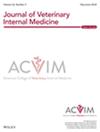Generalized Tremors in Dogs: 198 Cases (2003–2023)
Abstract
Background
Diseases associated with generalized tremors in dogs have not been extensively investigated in a large population of dogs.
Hypothesis/Objectives
Describe semiology, tremor phenotype, and diseases associated with generalized tremors in dogs, and identify clinical features that could be associated with the underlying disease.
Animals
A total of 198 dogs.
Methods
Retrospective, single-center study of dogs with generalized tremors and a final or presumptive diagnosis between January 2003 and December 2023.
Results
The most common diseases associated with generalized tremors in dogs were intoxication (91/198; 46%), idiopathic generalized tremor syndrome (IGTS; 49/198; 24.7%), hypocalcemia (13/198; 6.6%), meningoencephalitis of unknown origin (MUO; 9/198; 4.5%), hypoglycemia (6/198; 3%), hypercalcemia (5/198; 2.5%) and degenerative encephalopathies (5/198; 2.5%). Dogs with IGTS were females (p = 0.002), younger (p = 0.002) with an acute progressive lateralizing presentation (p < 0.001 for all three), compared to dogs with intoxication that were males (p = 0.002), young and middle-aged (p = 0.002) with a hyperacute nonprogressive symmetric presentation (p < 0.001 for all three). Behavioral changes (p = 0.01), hypersalivation (p = 0.04), abnormal mentation (p = 0.01), bilateral mydriasis (p = 0.02) or generalized hyperesthesia (p = 0.002) were common in intoxication, whereas hyporexia and vestibulocerebellar signs (p < 0.001 both) were common in IGTS. Dogs manifested only tremors in intoxication (45%) compared with IGTS (22%; p = 0.01). Improvement within 48 h from the onset of signs without corticosteroid treatment occurred exclusively in dogs with intoxication (p < 0.001).
Conclusions and Clinical Importance
Intoxication and IGTS were the most common diseases associated with generalized tremors in dogs. Historical and clinical features may aid the clinician in adjusting their differential diagnoses and formulating a diagnostic and treatment plan.

 求助内容:
求助内容: 应助结果提醒方式:
应助结果提醒方式:


